#1967 European Cup
Text
#OTD in 1967 – Celtic Football Club become the first Scottish and northern European team to win the European Cup, beating Inter 2-1 in the Estádio Nacional, in Lisbon, Portugal.
#OTD in 1967 – Celtic Football Club become the first Scottish and northern European team to win the European Cup, beating Inter 2-1 in the Estádio Nacional, in Lisbon, Portugal.
An estimated crowd of 70,000 crammed into the Estádio Nacional near Lisbon, Portugal to witness the Glasgow side lift the greatest prize in club football, defeating Inter Milan 2–1. As the final whistle blew, euphoric Celtic fans poured onto the pitch to celebrate their team’s victory, many whooping with joy and waving banners.
Jock Stein, said: “There is not a prouder man on God’s Earth than me…

View On WordPress
#1967 European Cup#Andrew Kerins#Brother Walfrid#Celtic Football Club#Co. Sligo#Estádio Nacional#Glasgow#Inter Milan#Irish Marist Brother#Jock Stein#Lisbon#Lisbon Lions#Mayo#Portugal#Portuguese National Stadium#Scottish Club
6 notes
·
View notes
Text

Franz Beckenbauer, who has died aged 78, was widely regarded as the best footballer Germany has ever produced. A pre-eminent figure in the world game after the second world war, he was a phenomenally innovative player who captained West Germany to a World Cup win in 1974 and later managed his country to two consecutive World Cup finals, winning the second of them in 1990 in Rome.
As a club manager he added a Bundesliga title and a Uefa Cup win to his World Cup victory at international level and as a player he won a World Cup, a European Championship, three European Cups and five Bundesliga titles in Germany. However, more than his capacity for winning, it was the elegant, intelligent nature of his play that attracted such admiration all over the world.
While he was still a teenager at Bayern Munich, Beckenbauer had become the virtual inventor of what came to be called “total football”. Watching the Milan team Internazionale on television, he was impressed by the attacking forays of their big left-back, Giacinto Facchetti. He asked himself why a defender might not attack from a central role as well as from the flanks, and thus became Bayern’s attacking libero. It was a role that became the cornerstone of the total football practised by Bayern and their great Dutch rivals, Ajax, in the early 1970s.
Captained by Beckenbauer – a tall, erect figure always ready to sweep out of defence – Bayern at first played second fiddle to Ajax, but eventually emulated them by winning the European Cup three times in a row, between 1974 and 1976. Before that sequence Beckenbauer had already captained an outstanding West Germany team to the European Championship title in 1972, beating the Soviet Union 3-0 in the final. Two years later he led his country to victory in the 1974 World Cup on German soil, defeating the Netherlands 2-1. He played 103 times for West Germany and appeared in 427 league matches for Bayern.
Franz was born to Antonie (nee Huphauf) and Franz Sr, a postal worker in the Munich suburb of Giesing, near the stadium where he would make his name. By the age of eight he was already regarded as a technically accomplished player, even in a city where footballers and football proliferated. Munich 1860 was the club he favoured; Bayern Munich, where he would later excel, were small beer at the time; an upstart by comparison.
However, Munich 1860’s loss would be Bayern’s gain. In 1958 he was playing for the junior team of a little local club, SC 1906, which actually closed that year, and expected to join 1860. “But in the last game we played for SC 1906 against 1860,” he related, “a half-back gave me a slap. That was enough for me. 1860 would never get me. And so Bayern took me into its ranks.” Beckenbauer was, with rare exceptions, always a sporting player, who declared that he would rather be fouled and leave the field than commit a foul himself.
He made his debut for Bayern Munich in 1964 – when they were in the German second division – and in his first season helped them gain promotion to the Bundesliga.
Thereafter Bayern rapidly became a major force both at home and in Europe, winning the German Cup in 1966–67 and the European Cup Winners’ Cup in 1967 (against Rangers). Beckenbauer was made team captain for the 1968–69 season and led the club to its first league title that year, subsequently winning three league championships in a row from 1972 to 1974 and that hat-trick of European Cup wins in 1974-76.
Under his leadership (he was nicknamed the Kaiser for his commanding, almost imperious presence) the Bayern team of that era, which also featured greats such as the goalkeeper Sepp Maier and the centre-forward Gerd Müller, established itself as one of the most accomplished club sides of all time.
Beckenbauer’s first game for the national team, at the age of 21 in 1965, had come even before Bayern’s dramatic rise to prominence. He was the star member of the West Germany side in the 1966 World Cup finals, where they were runners-up in the Wembley final to England, and again in the 1970 finals in Mexico, where they finished in third place.
Helmut Schön, the tall, gentle West Germany team manager who was almost a father figure to Beckenbauer, for many years refused to let him play the libero role for his country. When he finally relented in 1974, West Germany won the competition and Beckenbauer lifted the trophy as captain.
All seemed set fair for a fourth World Cup campaign for Beckenbauer in Argentina in 1978, but to general surprise, and aged only 31, he retired from international football in 1977 to switch to play for New York Cosmos in the North American Soccer League.
It was an unusual move after almost 15 years at the highest level of the game with Bayern, but the contract was lucrative and enormous crowds came to see him play with Pelé and other stars at the Giants Stadium, New Jersey.
In his four seasons with the Cosmos the team won the national Soccer Bowl on three occasions (1977, 1978 and 1980). “I’ve done everything in my life – championships for Bayern Munich and the World Cup for Germany – but the New York Cosmos was the best time of my life,” he said. “At Munich it was all German players; at the Cosmos it was 14 nationalities and Pelé.”
He returned to Germany to play for Hamburg (1980-82), where he picked up another Bundesliga winners’ medal at the end of the 1981-82 season before going back to the US for one final campaign with the Cosmos in 1983 and then retiring. In his career in domestic leagues he had made 587 appearances and scored 81 goals.
When Beckenbauer retired he seemed to have no ambition to go into management, so it was a surprise that in 1984 he agreed to manage West Germany in succession to Jupp Derwall. Never before had a West Germany manager been appointed who had not come through the exhaustive qualifying programme of the German football association, one which involved not only the passing of examinations but the running of minor clubs.
In appointing Beckenbauer, the German authorities were abandoning firm principle in the hope that his immense prestige and authority would prevail; and they were not disappointed.
The team he inherited was in the doldrums, yet at the 1986 Mexico World Cup, suitably inspired, they reached a final in which they were plainly inferior to an Argentina team that went into a 2-0 lead, only for the Germans to fight back, catch them up, and then lose 3-2. Four years later, in a grisly final in Rome, Germany had their revenge, beating Argentina 1-0 with a penalty by Andreas Brehme.
Shortly afterwards Beckenbauer resigned his position to became technical director of the French club Marseille on a two-year contract worth nearly £500,000, taking a German physical trainer with him. But for once his writ did not run. The French players were unhappy with the training regime and Beckenbauer withdrew after just four months.
He was far happier when he returned to Bayern Munich to serve as manager over two short spells – in 1993-94 and in 1996 – during which time he collected two further honours, the Bundesliga title in 1994 and the Uefa Cup in 1996. Thereafter he was president of the club for two years.
In 1998 he became vice-president of the German football association and at the end of the 90s headed the successful bid by Germany to host the 2006 World Cup, chairing the subsequent organising committee. He was named honorary president of Bayern Munich in 2009, a position he held until his death.
His son, Thomas, with Ingrid Grönke was born in 1963. In 1966 he married Brigitte Wittmann. They had two sons, Michael and Stephan. Following their divorce in 1990, he married Sybille Weimer; they divorced in 2004. With his third wife, Heidi Burmester, he had two children, Noel and Francesca. Stephan, who was also a footballer and played for Bayern Munich, died in 2015. Franz leaves Heidi and his four other children.
🔔 Franz Anton Beckenbauer, footballer, born 11 September 1945; died 7 January 2024
Daily inspiration. Discover more photos at Just for Books…?
22 notes
·
View notes
Photo

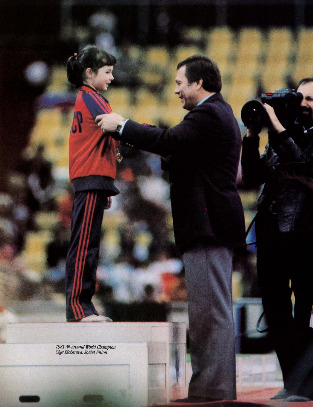


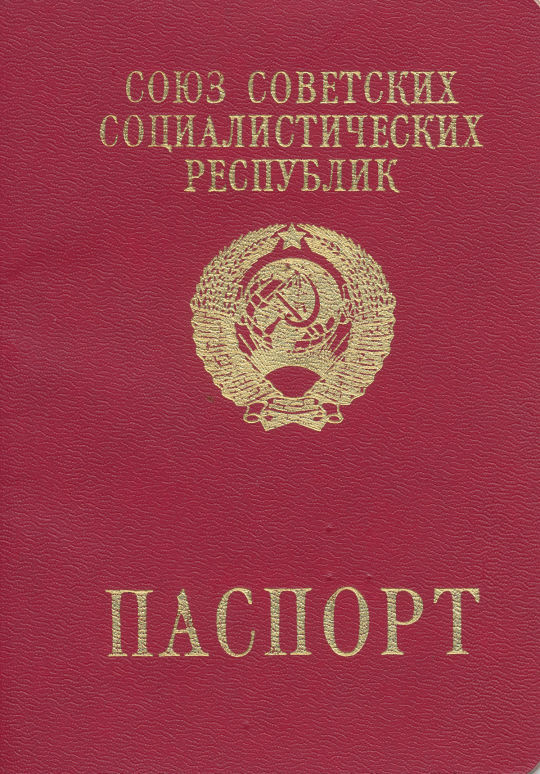




A non-exhaustive list of gymnasts whose ages are known to be falsified.
“Dick does she look 14 years old to you? [...] I tell you we have a story going around the gymnastics community that is pretty traditional that when a young Romanian girl is asked her age she looks to her coach for the answer.” --Bart Conner, 1985 American Cup
Since Wikipedia can’t be trusted to be right for a lot of details of gymnasts careers...
Olga Bicherova
Born in either 1967 or 1968, during Bicherova’s elite career the age requirement was that you had to turn 15 in the year of competition. Either birthdate would have made her too young for the 1981 World Championships where she won two gold medals, one in the all around and one with the team. If you take the 1967 birthdate she could have been age eligible for the 1982 World Cup where she won 5 medals, 3 of them gold except that one of the requirements of the World Cup at that time was previous participation in the World Championships. [In fairness to Bicherova the above picture is slightly mean of me to use as she never grew very tall.]
Ecaterina Szabo
Born in 1968, during Szabo’s elite career the age requirement was to turn 15 in the year of competition meaning her first year of senior eligibility should have been 1983 and 1983 is when her first major titles occurred. Except she was competing as a senior in 1982 winning a number of international invitationals (which she may have been eligible for anyway because juniors and seniors often competed together at those). It’s unclear to me why her birthdate was changed though it might have simply been something that happened when the government changed her name to hide her Hungarian ethnicity. Szabo’s first language is Hungarian and she was born in Transylvania as Szabó Katalin. She still goes by Katalin in her private life. She was of age during the 1984 Olympic Games and the 1983 World Championships
Olga Mostepanova
Born in 1970, during Mostepanova’s elite career the age requirement was to turn 15 in the year of competition (or 14 for the World Championship that qualified for the Olympics). She has said herself that while she was competing her passport was wrong by “years”. By the accounts as I understand them her first senior year should have been 1985. Mostepanova was the top Soviet gymnast in 1984 winning the alternative games held for countries that boycotted the 1984 Olympic Games (and the reality of her age falsification makes playing ‘What if?’ for who should have won the 1984 Olympics awkward). Aside from her 5 Friendship Games gold medals, she would have also been age ineligible for the 1983 World Championships where she won 4 medals, 2 gold (team and beam) and 2 silver (all around and floor).
Oksana Omelianchik
Born on January 2, 1970, during Omelianchik’s elite career the age requirement was to be turn 15 in the year of competition and her first year of eligability was 1985. None of Omelianchik’s elite career honors are tainted however she says at one point she was given a passport with her birthdate shifted by a week (which would have made her able to compete in the 1984 Olympic Games).
Daniela Silivaș
Born in 1972, during Silivaș’ elite career the age requirement was that you turn 15 in the year of competition meaning her first year as a senior elite should have been 1987. In 1985 she won a European bronze medal on beam, a World Championship gold medal on beam and a silver with the team. She also won 3 medals at the 1986 World Cup. She was of age for the 1988 Olympic Games
Kim Gwang-suk
Only the universe knows what year Kim Gwang-suk was actually born. She was listed as 15 years old for three consecutive years by the North Korean government from 1989-1991, and then 17 years old at the 1992 Olympic Games. She may have been as young as 11 when she competed in the 1989 World Championships. In 1991 she won the World Championship gold on the uneven bars and at least one of her birth years means she might have been age eligible for that competition (which may be why FIG was reluctant to take away that medal, officially they decided that as she wasn’t personally involved in the fraud she could keep it). The North Korean team was banned from the 1993 World Championships for the sloppy fraud.
Alexandra Marinescu
Born in 1982, the age requirements changed in the middle of Marinescu’s elite career. For the 1996 Olympic Gams you had to turn 15 in the year of competition and starting in 1997 you had to turn 16. The Romanian state issued her a passport giving her birthdate as 1981 and it is worth noting that this was the post revolution Romanian government. She competed at 1995 Worlds, 1996 Worlds, and the 1996 Olympic Games with a stated birthdate that would make her just old enough to compete in those competitions. In fact she was younger than both Dominique Moceanu and Vanessa Atler. At no point during her entire elite career which lasted 3 years was Marinescu of age. She has 3 World medals (2 gold for the team in 1995 and 1997, 1 silver on beam from 1996), and one Olympic medal (bronze in the team from 1996). The FIG database still lists her incorrect birth year and the Romanian gymnastics federation claims that she is lying about the age falsification (as well as other abuses she has been outspoken about).
Dong Fangxiao
Born sometime in January of 1986 (the exact day is still disputed), during Dong’s elite career the age requirement was to turn 16 in the year of competition. Her first year of senior competition should have been 2001 but she competed at the 1999 World Championships under the rule at the time that if you are eligible for the Olympic Games you cold compete at the World Championships the previous year. She won a bronze medal at both 1999 Worlds and the 2000 Olympics with the team. In 2008 she applied to be a technical official at the Beijing Olympic Games she listed her true birthdate instead of the 1983 birthday under which she had competed. An investigation of the case resulted in both medals being stripped.
Hong Su-jong
At different competitions during her career Hong Su-jong was entered with a birth year of 1985, 1986, and 1989. At some of these competitions she was entered with a different birth year as her twin sister Hong Un-jong (Olympic and World Champion who has never herself been implicated in age falsification). Hong Su-jong’s most significant medal was the 2007 World silver on vault which she is believed to be of age for but she competed at the 2004 Olympic Games with the 1985 birthdate and for that competition she was too young. Hong Su-jong was eventually banned permanently from competition and North Korea was banned until October 2012 meaning that her sister was unable to defend her 2008 Olympic vault gold.
You may notice that He Kexin is not on this list...
During (and after) the 2008 Olympic Games questions were raised about two time Olympic Gold medalist He Kexin’s age (as well as that of several of her team mates). Unlike all of the above cases where either inconsistent age information was entered at official FIG competitions or the gymnast themselves have stated that their birth year was changed, He’s birthdate has always been consistent in FIG documents and she herself has always denied falsification. Her age was listed as earlier in entries for some domestic meets and that was reported by foreign press as evidence that she was too young. This ignores the fact that age falsification (in both directions up and down) was common by city and provincial teams in China to enter age bracketed competitions and that is what may have been going on. Either way these competitions are not governed by the FIG so the inconsistent birth information at them was not their problem. I am generally agnostic about He’s birth year. There is strong circumstantial evidence to suggest that her age was changed (that doesn’t have to do with domestic competition forms or her appearance) however I understand why the FIG investigation decided that there was not enough evidence for them to act.
Sooooo the only people punished for age falsification have been Asians. That’s kind of racist isn’t it?
Two things can be true at the same time. Yes it is highly suspicious that only North Korea and China have been punished for this while there are documented cases of European federations also doing this. However I think it’s important to note that these cases are not all the same. North Korea was punished for providing inconsistent birthdates for the same gymnast at competitions. The evidence of the offense was right there in FIG’s paperwork. China was punished when Dong applied to be an official with FIG giving an inconsistent birth year.
All of these other cases involve gymnasts whose paperwork was consistent during their careers.
The fact that FIG is only accepts that level of proof and unwilling to accept (especially in Marinescu’s case) the gymnasts own statements about their birth year certainly doesn’t make them look like they are particularly interested in punishing this kind of cheating unless absolutely forced to. I would offer the counter point that FIG is not the police and they do not have the ability to determine if there is something else going on with such public statements and they often came out well after the standard 10 year statute of limitation for stripping medals (except in the case of Marinescu). Some have suggested that FIG was reluctant to act on Marinescu’s statements because stripping Romania of those medals would promote China who was also age cheating at the time. I don’t think you have to go to that place when the answer is just as likely that FIG has a very narrow standard of proof for revoking medals on the basis of age falsification and has even erred on the side of allowing the gymnast (Kim Gwang-suk) to keep a medal won while clearly under age.
Are FIG officials racist against Asians? There is a lot of evidence for that.
Has FIG only punished Asian nations for age falsification? Yes. But it’s more a case that North Korea is really bad at this and the Dong case has fairly unique circumstances.
#gymnastics#olga bicherova#daniela silivas#he kexin#hong un-jong#hong su-jong#alexandra marinescu#olga mostepanova#oksana omelianchik#ecaterina szabo#kim gwang-suk
55 notes
·
View notes
Text
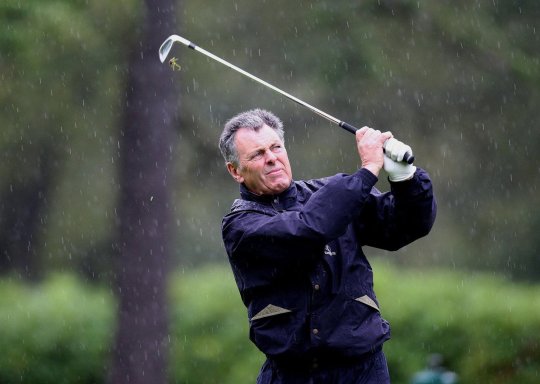


Scottish Golfer Bernard Gallacher was born on February 9th 1949.
75 year old Bernard Gallacher is a battle-hardened player from Bathgate, and was the original young wonder of the PGA European Tour, he won the 1967 Scottish Amateur Open Stroke Play Championship and turned professional the same year, winning the PGA Championship just two years after turning professional. Thirteen more titles followed in between the demands of Bernard’s other job as the club professional at Wentworth.
Bernard Gallacher played in every Ryder Cup from 1969-83. In the late ‘80’s he helped Tony Jacklin before taking over the captaincy in 1991. Unlucky in his first year, Bernard won the Cup as Captain on his third attempt. His calm and collected leadership was vital to the European team’s stunning victory at Oak Hill in New York State.
Following a quarter of a century as Club Professional, Bernard Gallacher left Wentworth at the end of 1996. In 1997, he spent more time with his family and played more golf. Bernard also commentated on the Ryder Cup for Sky and worked with various blue chip companies, particularly on their corporate entertainment where – following his time at Wentworth – he is regarded as a “golf day specialist”.
Bernard turned fifty in 1999 and has played on the European Seniors Tour ever since. Well apart from some time out having survived a sudden cardiac arrest, and having to be resuscitated 3 times! He thought he would never be able to play the game he loves again, but was back on the course 9 months later.
With a long and prestigious career, Bernard has had the opportunity to work with various blue chip companies, particularly on their corporate entertainment. Widely regarded as a “golf day specialist”, an accomplished speaker, and also as a leading media commentator for BBC Radio Five Live, he now works as an anecdotal sports speaker appearing at corporate and club events as well as specialist after dinner speaker events.
Bernard is obviously very well thought of down at Wentworth Golf Club, a statue of the Scotsman is placed at first tee at West Course in Surrey, England.
One of his daughters is the lovely TV presenter Kirsty Gallacher, the other is Laura Gallacher, now Laura Brand after she married the controversial TV and radio presenter ARussel Brand, she is a Blogger, author and illustrator.
4 notes
·
View notes
Text
. He was the European Cup top scorer in 1964–65, 1965–66 and 1967–68. He also won the Bola de Prata for the Primeira Liga top scorer a record seven times. He was the first ever player to win the European Golden Boot, in 1968, a feat he replicated in 1973
0 notes
Text
Meeting the Quidditch Players - The Wolf's Tail
With the inaugural International School's Quidditch Cup taking place in the Marauder's Fifth year of The Wolf's Tail , 63 foreign teen Quidditch players and their coaches have descended on Hogwarts and, although every player won't be named in the fic (that's a lot to fit in) each player for every team has been created in my notes. Some of their names are a mixture of canon names and/ or names with mythological/ historical/ cultural or flight related links ... and as there won't be room to go into them in the fic, I thought I would post some of the extra details here. First up, the English speaking schools:
Hogwarts
Gwenog Jones (beater) - the youngest player on the team is the canonical captain of the Holyhead Harpies in Harry's time. A great heroine of Ginny's, Hermione meets her at the slug club and is unimpressed.
Sidhe Moran (chaser) - A member of the 1994 World Cup Irish winning team. Sidhe (roughly pronounced like "five" but starting with an s) is an Irish name which comes from the name for the fairy people who live under the hills.
Ilvermorny
Memengwaa Campbell (seeker) - A First Nations Canadian witch (with a Scottish great great great grandfather), she is from the Ojibwe tribe and her name means "butterfly".
Bertram Aubrey (chaser) - A character canonically famous for having an illegal hex performed on him by one James Potter. Bertram ended up in the Hospital Wing with his head twice the regular size, James ended up in detention.
Diego Di Marco (chaser) - A Mexican wizard and a love interest for Lily, he is named after Don Juan for his last name and has been given a Spanish version of Casanova's first name as his given name. Cassanova's name was Giancomo, which is Italian for ... James
Beau Rogers and Jesse Bonney (beaters) - take their name from assorted famous cowboys/ outlaws notably Will Rogers, Jesse James and William Bonney (Billy the Kid)
Mister Wright (coach) - Named after the Wright brothers.
Yeperenye School of Sorcery
Harold Holt-Bishop (keeper) - The vanishing keeper, named after two Australians who famously vanished. Harold Holt was the 17th Australian Prime Minister who disappeared in 1967 and was never found, and Harold Bishop - a character in long running Aussie soap "Neighbours" - who was lost at sea in 1991 but who was found safe and well (if suffering from amnesia) in 1996. Harold left Ramsey Street for the final time (perhaps) in late 2023.
Ned Barrett (beater) - Takes his name from famous Australian outlaw, Ned Kelly
Basil Burrunjor (chaser) - A Burrunjor is a mythological giant lizard. The first European witch in Australia - and founder of Yeperenye - Joanna Jamieson, fashioned herself a new wand from wattlewood and the heartstring of a burrunjor upon her release from prison (she had been transported for the crime of fraud, after she vanished her neighbour's cow and the authorities refused to recognise she was a witch).
Alinta Gunidjaa (seeker) - Alinta is an Aboriginal Australian and thus has come to Yeperenye via the "Aboriginal Controversy" following the muggle policy of separating native children from their parents. Aboriginal Australians did not traditionally have last names and so were assigned them by the white authorities. Wizarding assigned last names are based off native Australian flora and fauna. A Gunidjaa is a black faced cuckoo shrike, but cruelly is also an Aboriginal word for "motherless child" or "orphan" - the irony being Alinta is not an orphan, she has been stolen from her parents.
Madam Larrikin (coach) - like Alinta she is named after a native bird and so is probably an Aboriginal Australian who came to Yeperenye after ending up in a muggle home. Larrikin can also be used as a pejorative name "you cheeky Larrikin" - which along with Alinta's name - suggests there is a certain amount of racism involved in the bestowing of last names on Aboriginal wizards.
This post is getting quite long, so I'll return tomorrow with another post for the other schools (Durmstrang might need a post all to themselves).
Link to part 2
1 note
·
View note
Text
Zagallo! 1931 — 2024
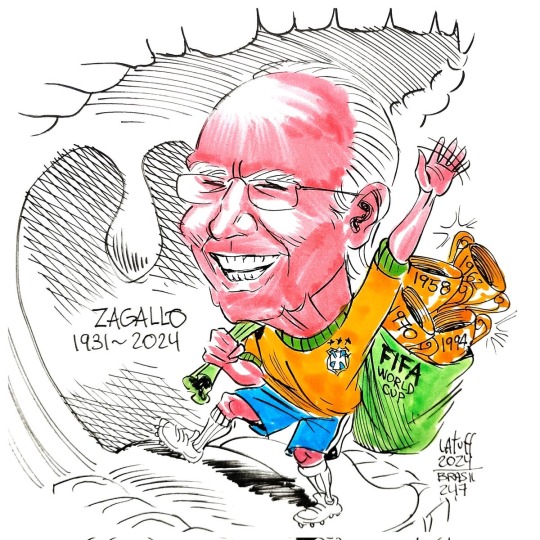
Cartoon By Carlos Latuff
Mário Jorge Lobo Zagallo (9 August 1931 – 5 January 2024) was a Brazilian Professional Football Player, Coordinator and Manager, Who Played as a Forward.
Zagallo holds the record for World Cup titles in general with four titles in total. He also holds the record for World Cup finals with six participations. He was the first person to win the FIFA World Cup as both a manager and as a player, winning the competition in 1958 and 1962 as a player and in 1970 as Manager. In addition, he won the 1994 FIFA World Cup as Assistant Manager. Zagallo also coached Brazil in 1974 (Finishing Fourth) and in 1998 (Finishing as Runners-up) and was a technical assistant in 2006. He was the first of three men, along with Germany's Franz Beckenbauer and France's Didier Deschamps to have won the World Cup as a player and as a manager, and the only one who had done it more than twice.
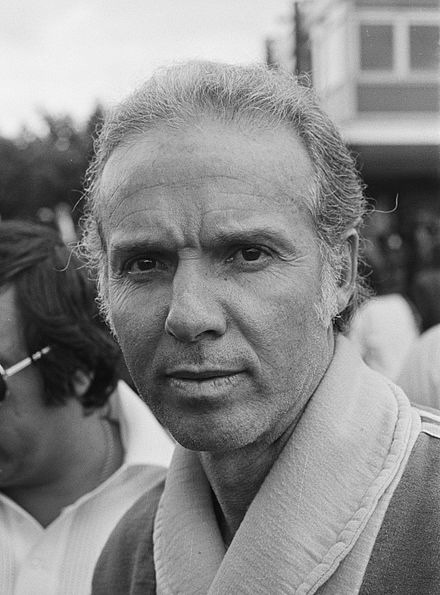
In 1992, Zagallo received the FIFA Order of Merit, the highest honour awarded by FIFA, for his contributions to football. He was named the 9th Greatest Manager of All Time by World Soccer Magazine in 2013. On 5 January 2024, Zagallo died at the age of 92. He was the last surviving Brazilian player who participated in the 1958 World Cup final.
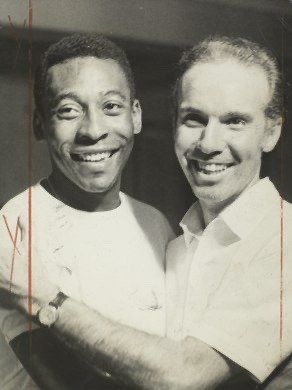

Zagallo with Pelé in 1970 (Left)! Zagallo During His Playing Career (Right)!
Zagallo was born in Atalaia in the northeastern state of Alagoas on 9 August 1931. As a young man, he worked as a soldier and was deployed at the Maracanã Stadium when Uruguay defeated Brazil in the 1950 World Cup final.
Zagallo started his football career with América in 1948, and he later played for Flamengo and Botafogo. Zagallo won the World Cup as a player with Brazil in 1958 and 1962. At the time of the 1958 tournament, Zagallo was a Flamengo player, but by the 1962 event, he was with Botafogo. Zagallo won a total of 33 caps for Brazil between 1958 and 1964.
Managerial Life
Zagallo started his managerial career at Botafogo, the club he had finished his career with, managing them alongside the Brazil national team. Zagallo won the World Cup as a manager in 1970, and as assistant coach in 1994, both with Brazil. He was the first person to win the World Cup both as a player and as a manager. Winning the World Cup in 1970 at the age of 38, he is also the second youngest coach to win a World Cup, after Alberto Suppici, who won aged 31 with Uruguay in 1930.
Zagallo's Brazil team in 1970 played a 4–2–3–1 formation. The team prepared for nearly three months for the tournament, acclimatising to the heat and altitude of the Mexican summer. Zagallo said that the team won most of their games in the second half, where they scored 12 of their 19 goals as opponents tired.
At the 1974 FIFA World Cup in West Germany, Zagallo was disadvantaged by the international retirement of Pelé four years earlier, as well as injuries to Tostão and Carlos Alberto Torres, meaning that only two starting players from the 1970 final were in the squad. Additionally, the team had a lack of competitive practice due to the shelving of the Copa América between 1967 and 1975. In response to Brazil being eliminated by overly physical European sides in 1954 and 1966, Zagallo chose to play in an equally aggressive way. Brazil narrowly made it through the first group stage by one goal in goal difference over Scotland, and missed out on the final after a 2–0 loss to the Netherlands, in which Luís Pereira was sent off for a foul on Johan Neeskens. Poland then defeated Brazil in the third-place playoff.
In 1989, Zagallo was hired by the United Arab Emirates for their qualification campaign for the 1990 FIFA World Cup. He led the amateurs to an unexpected first qualification to the tournament, but left for Vasco da Gama days before the World Cup began and was replaced by Carlos Alberto Parreira.
In November 2002, Zagallo came out of retirement to coach Brazil again, following Luiz Felipe Scolari's exit after winning that year's World Cup. On 20 November, in his only game, the team won 3–2 in a friendly away to South Korea.
Personal Life
Zagallo married Alcina de Castro on 13 January 1955 at the Church of Capuchins in Rio de Janeiro. They remained together until de Castro's death on 5 November 2012.[18] Mário and Alcina had four children. He was a practicing Catholic.
Zagallo's surname was spelled Zagalo for most of his career, including by himself, until he told a reporter in the 1990s that his surname on his birth certificate was Zagallo. He was also the only Brazilian World Cup-winning forward to be known by his surname.
In July 2022, Zagallo was admitted to hospital with a respiratory infection. In August 2023, he was hospitalized for 22 days due to a urinary infection. Following a brief hospitalization in Rio de Janeiro, He Died on 5 January 2024 due to Multiple Organ Failure, resulting from the exacerbation of various pre-existing comorbidities. Zagallo was aged 92.
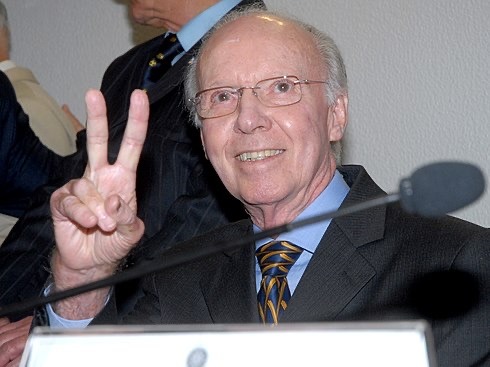
Zagallo in 2008
Nicknames
Zagallo was nicknamed The Professor by his players throughout his coaching career, due to his tactical awareness and commanding presence on the bench. He was also nicknamed Velho Lobo ("Old Wolf") due to his surname "Lobo", which means "Wolf".

1 note
·
View note
Text
Events 12.19 (after 1950)
1956 – Irish-born physician John Bodkin Adams is arrested in connection with the suspicious deaths of more than 160 patients. Eventually he is convicted only of minor charges.
1961 – India annexes Daman and Diu, part of Portuguese India.
1967 – Harold Holt, the Prime Minister of Australia, is officially presumed dead.
1972 – Apollo program: The last crewed lunar flight, Apollo 17, carrying Eugene Cernan, Ronald Evans, and Harrison Schmitt, returns to Earth.
1974 – Nelson Rockefeller is sworn in as Vice President of the United States under President Gerald Ford under the provisions of the 25th Amendment to the United States Constitution.
1977 – The Ms 5.8 Bob–Tangol earthquake strikes Kerman Province in Iran, destroying villages and killing 665 people.
1981 – Sixteen lives are lost when the Penlee lifeboat goes to the aid of the stricken coaster Union Star in heavy seas.
1983 – The original FIFA World Cup trophy, the Jules Rimet Trophy, is stolen from the headquarters of the Brazilian Football Confederation in Rio de Janeiro, Brazil.
1984 – The Sino-British Joint Declaration, stating that China would resume the exercise of sovereignty over Hong Kong and the United Kingdom would restore Hong Kong to China with effect from July 1, 1997, is signed in Beijing by Deng Xiaoping and Margaret Thatcher.
1985 – Aeroflot Flight 101/435 is hijacked to China by its first officer.
1986 – Mikhail Gorbachev, leader of the Soviet Union, releases Andrei Sakharov and his wife from exile in Gorky.
1991 – Joe Cole, American roadie and author, is killed in an armed robbery.
1995 – The United States Government restores federal recognition to the Nottawaseppi Huron Band of Potawatomi Native American tribe.
1997 – SilkAir Flight 185 crashes into the Musi River, near Palembang in Indonesia, killing 104.
1998 – President Bill Clinton is impeached by the United States House of Representatives, becoming the second president of the United States to be impeached.
2000 – The Leninist Guerrilla Units wing of the Communist Labour Party of Turkey/Leninist attack a Nationalist Movement Party office in Istanbul, Turkey, killing one person and injuring three.
2001 – A record high barometric pressure of 1,085.6 hectopascals (32.06 inHg) is recorded at Tosontsengel, Khövsgöl, Mongolia.
2001 – Argentine economic crisis: December riots: Riots erupt in Buenos Aires, Argentina.
2005 – Chalk's Ocean Airways Flight 101 crashes into the Government Cut channel immediately after takeoff from Miami Seaplane Base, killing 20.
2012 – Park Geun-hye is elected the first female president of South Korea.
2013 – Spacecraft Gaia is launched by the European Space Agency.
2016 – Russian ambassador to Turkey Andrei Karlov is assassinated while at an art exhibition in Ankara. The assassin, Mevlüt Mert Altıntaş, is shot and killed by a Turkish guard.
2016 – A vehicular attack in Berlin, Germany, kills and injures multiple people at a Christmas market.
0 notes
Text
Top 5 @Wikipedia pages from yesterday: Tuesday, 12th December 2023
Welcome, 환영 (hwanyeong), fáilte, bun venit 🤗
What were the top pages visited on @Wikipedia (12th December 2023) 🏆🌟🔥?

1️⃣: Tommy DeVito (American football)
"Thomas N. DeVito (born August 7, 1998) is an American football quarterback for the New York Giants of the National Football League (NFL). He played college football at Syracuse before transferring to Illinois...."

Image licensed under CC BY-SA 2.0? by TigerNet.com
2️⃣: Animal (2023 film)
"Animal is a 2023 Indian Hindi-language action drama film directed and edited by Sandeep Reddy Vanga, who also co-wrote the screenplay with Pranay Reddy Vanga and Saurabh Gupta. The film is produced by Bhushan Kumar, Krishan Kumar, Murad Khetani and Pranay Reddy Vanga under T-Series Films, Bhadrakali..."
3️⃣: Leave the World Behind (film)
"Leave the World Behind is a 2023 American apocalyptic psychological thriller film produced, written and directed by Sam Esmail. It is based on the 2020 novel of the same name by Rumaan Alam. The film stars Julia Roberts, Mahershala Ali, Ethan Hawke, Myha'la, and Kevin Bacon as they attempt to make..."
4️⃣: Bhajan Lal Sharma
"Bhajan Lal Sharma (born 15 December 1967) is an Indian politician designated to take charge as the 14th Chief Minister of Rajasthan with Diya Kumari and Prem Chand Bairwa as deputy since December 2023. He is a member of the 16th Rajasthan Legislative Assembly, representing the Sanganer constituency...."

Image licensed under CC BY-SA 4.0? by Bhajan Lal Sharma
5️⃣: UEFA Champions League
"The UEFA Champions League (previously known as the European Cup and mostly abbreviated worldwide as the UCL) is an annual club association football competition organised by the Union of European Football Associations (UEFA) and contested by top-division European clubs, deciding the competition..."
0 notes
Text
Top 20 memorable Ryder Cup moments from the history of the tournament:
1. **Inaugural Ryder Cup (1927)**: The first Ryder Cup was held at Worcester Country Club in Massachusetts, marking the beginning of this prestigious golf event.
2. **Ben Hogan's Comeback (1967)**: Ben Hogan returned to competitive golf at age 54 to captain the U.S. team to victory, showcasing his enduring talent and determination.
3. **Seve Ballesteros' Debut (1979)**: A young Seve Ballesteros made his Ryder Cup debut and quickly became a crowd favorite for his dynamic play.
4. **The "War on the Shore" (1991)**: The intense competition between the U.S. and European teams led to a nail-biting finish, with the U.S. winning on the final hole.
5. **Justin Leonard's Putt (1999)**: Leonard's dramatic 45-foot putt on the 17th hole at Brookline is one of the most iconic moments in Ryder Cup history.
6. **The Miracle at Medinah (2012)**: Team Europe staged a remarkable comeback, overcoming a significant deficit on the final day to retain the Cup.
7. **Ballesteros and Olazábal's Partnership (Various)**: Seve Ballesteros and José María Olazábal formed a legendary Ryder Cup partnership, winning numerous matches together.
8. **Jack Nicklaus vs. Tony Jacklin (1969)**: The "Concession" at Royal Birkdale, where Nicklaus conceded a short putt to Jacklin to end the event in a tie, exemplified sportsmanship.
9. **Bernard Gallacher's Captaincy (1995)**: Gallacher led the European team to their first victory on American soil, a pivotal moment in Ryder Cup history.
10. **Tom Watson's Chip-In (1993)**: Watson's incredible chip-in at The Belfry secured a crucial point for the U.S. team.
11. **Ian Poulter's Passion (Various)**: Poulter's fiery and passionate performances have made him a Ryder Cup legend, earning him the nickname "The Postman" for delivering under pressure.
12. **Payne Stewart's Fist Pump (1999)**: Stewart's enthusiastic fist pump after a crucial putt at Brookline is an enduring image of Ryder Cup excitement.
13. **The "Battle of Brookline" (1999)**: Controversy arose due to excessive American celebrations during the matches at The Country Club in Brookline.
14. **The Concorde Trophy (1977)**: The U.S. and European teams competed for the Concorde Trophy, marking the 60th anniversary of Charles Lindbergh's solo flight.
15. **Rory McIlroy's Rally (2016)**: McIlroy's spirited comeback against Patrick Reed in the singles matches added to the drama of Hazeltine.
16. **Sam Torrance's Winning Putt (1985)**: Torrance's decisive putt at The Belfry secured victory for Europe and ignited celebrations.
17. **Larry Nelson's Singles Streak (1979)**: Nelson won all three of his singles matches, a rare feat in Ryder Cup history.
18. **Colin Montgomerie's Record (Various)**: Montgomerie's impressive Ryder Cup record of never losing a singles match solidified his status as a European stalwart.
19. **The Unflappable Tony Lema (1963)**: Lema's calm demeanor and great sportsmanship were highlighted during the 1963 Ryder Cup.
20. **Europe's Dominance (2000s)**: Europe's string of victories in the early 2000s signaled a shift in Ryder Cup dominance, with the team winning multiple consecutive tournaments.
These moments capture the essence of the Ryder Cup's rich history and the intense competition that makes it one of golf's most cherished events.
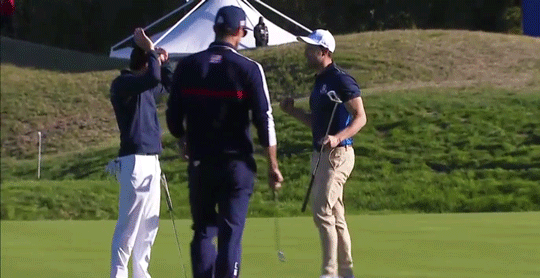
0 notes
Text

A framed photograph of the Cleveland Summit overlooks the desk of Allen Hopkins as he logs on at work each day. It records the 1967 meeting between Black athletes – Muhammad Ali, Bill Russell, and Kareem Abdul-Jabbar among them – and politicians to consider and eventually support Ali’s refusal to be drafted into the Vietnam war. That support sent a message – the fight for civil rights is a collective effort.
“When a Black player walks up to take a penalty, I can’t even watch,” says Hopkins, announced in July as the first executive director for Black Players for Change, a US-based collective of athletes, coaches, and staff working within Major League Soccer. “If he misses that penalty he is going to get his socials crushed. I can’t watch. I just never want a Black player to take a penalty … if he misses …”
He pauses as he tries to explain the complex balance between the hopes of the past, the reality of the present, and a collective dream for the future when it comes to fighting racism in soccer.
“But clearly, I actually do want the Black player to take the first penalty. Or the fifth penalty. Or be like Inter Miami goalkeeper Drake Callender and take a penalty [in a shootout] and then make the save for the next one [in the Leagues Cup final] and then just walk off.”
Black Players for Change was launched during the summer of 2020: Covid lockdowns met protests over blatantly racist killings. Say their names: Breonna Taylor, Ahmaud Arbery, George Floyd. MLS players wanted to say the names of those killed too and make a public stand for racial justice. Black Players for Change was born that July with an eight minute 46-second silent protest – sanctioned by MLS – before an Orlando City-Inter Miami match. It was a powerful moment.
Three summers on Black Players for Change provides a voice for athletes, advocating for soccer resources in underserved communities, lobbying for restorative justice and education when racism surfaces within the game. There is also a plan to take its mission internationally.
“The world has changed,” says Hopkins. “The Black player has ascended … Even in the US, if you look at player awards for 2022, they are all Black: Tyler Adams, Sophie Smith, Alyssa Thompson, Yunus Musah.”
Hopkins has a decades-long history within US soccer. He was as match announcer on Fox Sports’ fledgling coverage of European leagues before joining ESPN. He was an adviser to Jürgen Klinsmann during the German’s reign as head coach of the US men’s national team and has had several roles within Major League Soccer.
“When I worked for US Soccer with the national team I was one of one,” he says. “I can show you pictures at the White House where – outside of the players – I am the only Black person. We won the Gold Cup and – outside of the players – I am the only Black person there. I have a photo from college where we are lifting up a trophy that we won. I am the only Black person.”
Hopkins says he is never surprised when overt racism rears its head within the sport. It is part of his lived experience. When New York Red Bulls forward Dante Vanzeir was banned for making a racist comment during an MLS match against San Jose Earthquakes, Hopkins says the gamechanger was that multiple people heard what was said and spoke up. That hasn’t always been the case.
“Often it is he said-he said,” Hopkins says. “It happened to me when I played but I don’t think I had a teammate within earshot or anyone able to support me in that moment. The first time it happened to me personally I was shocked and couldn’t believe it because soccer was the one place it didn’t happen.”
So how to respond in the moment?
“My parents grew up in the Jim Crow south – rural Mississippi,” Hopkins says. “So I was raised by folks who were completely informed by that experience. The way they raised me was to take a very conservative safety-first path. Take care of yourself. These were the rules of the road.”
The Vanzeir incident, however, was managed by MLS and the players’ association in a way that Hopkins and Black Players for Change see as a meaningful way forward.
“We are not a cancel culture organization,” Hopkins says. “We were very happy that Vanzeir was part of a restorative justice conversation. Our members are the most gracious, kind, and empathic group of athletes I have ever been around. When issues have come up within MLS, where players have said racial things, it has been about how can we restore? How can we heal? How can we educate?”
But, he adds: “Not everything is perfect.”
Hopkins is referring to former DC United player Taxi Fountas whose contract with MLS was terminated by mutual agreement in August. Fountas had been placed on administrative leave by MLS in July after the league determined that allegations he used “prohibited and discriminatory language against another player” were credible. The “other player” he made racist comments to was a teammate. Time for restorative justice? Not exactly.
That July incident was a second offense and came just nine months after Fountas was alleged to have made racist comments towards Damion Lowe, who is Black, that were overheard by his Inter Miami teammate Aimé Mabika. That allegation could not be corroborated and Fountas received no sanction.
“We had an opportunity to give our feedback to MLS and the players’ association,” Hopkins says of the Fountas case. “We were clear that, no matter who he is, a player is not above [sanctions]. Having Fountas removed from the league and having MLS say why he was removed says a lot. It is also a wake up call for everyone else in the ecosystem and the community that that is the new bar now.”skip past newsletter promotion
after newsletter promotion
Fountas now plays for Trabzonspor in Turkey’s SuperLig.
“The reality is that Fountas was able to escape severe punishment the first time,” Hopkins says. “We want to try and help people be better and if they don’t want to be better then it’s time for Maya Angelou – when people tell you who they are, believe them the first time.”
While Black Players for Change has origins in the highest level of the sport it is also conscious of its roots. The organization has partnered with the US Soccer Foundation to build fields in underserved neighborhoods across the US, and aims to support Black coaches across all levels of the game while building stronger connections with its female counterpart the Black Women’s Player Collective and the Black Players Alliance, which represents players within the United Soccer League.
“The conversation we need to have is ‘How do we really bring the game to the Black community?’ Not Afro Latino. Not Afro Caribbean. Not African. Not African European, but the Black community overall. We can do a better job of that. We also want to ensure that putting in a new field in a city is not just a real estate play and cutting ribbons [for politicians]. We need to make sure that the next wave is creating communities – making it easy for our [professional] players to turn up and hang out and nutmeg little kids or for a facility to be used as a community center where people can hold their own events and do foundational work.”
Black Players for Change also sees a big window for global leadership tackling racism within the sport. The organization is currently discussing opportunities to lead education and intercultural awareness training with top-tier leagues and clubs in Europe.
“We have a lot of ground to cover just to get to a place where our default settings are humanity and empathy and understanding,” Hopkins says. “We can do it. I know it is ambitious but I see this thread through Fifa, Uefa, La Liga, the Bundesliga, Liga MX and MLS.”
Hopkins understands you have to follow the money and for big business – which top-top tier leagues most definitely are – not all publicity is good publicity.
“There are certain things in corporate America – the Fortune 50, 100, 500 – that you can’t be,” Hopkins says. “You can’t be homophobic and you can’t be racist. There is an element of brand protection and shareholder protection that goes into how businesses approach these issues and that is OK. We have to start somewhere. But dollars also means resources and having resources means having people to educate and to lead, and having more diverse candidates in senior positions.”
With the Cleveland Summit poster looking over his shoulder as he goes about his daily work, Hopkins has set a high bar for what he thinks Black Players for Change can achieve.
“We can eradicate racism in the context of sport,” he says.
What? Really? That’s some dream, surely?
“It’s not as Pollyanna as it sounds,” he says. “You can legislate, you can regulate, you can educate, you can train. We can get racism out of soccer and that should be our goal. With intentionality, it can be like a polio vaccine. The reality is that no one does activism like African Americans because that is just what we do. And no one does sports activism like Black athletes. That should be leveraged.”
0 notes
Text
Những điều cần biết về câu lạc bộ Real Madrid
Bên cạnh những câu lạc bộ nổi tiếng được nhắc đến thường xuyên như Bayern hay Liverpool. Thì trong số đó câu lạc bộ Real Madrid cũng là một cái tên nổi tiếng được nhiều người hâm mộ trên thế giới biết đến. Vậy hãy cùng France98 khám phá về đội bóng này qua bài viết này nhé.
Giới thiệu chung về CLB Real Madrid

Real Madrid Club de Fútbol, thường được gọi là Real Madrid hoặc viết tắt là "Los Blancos", là một câu lạc bộ bóng đá hàng đầu tại Tây Ban Nha và toàn cầu. Đây là một trong những câu lạc bộ nổi tiếng và thành công nhất trong lịch sử bóng đá thế giới. Dưới đây là một số thông tin chung về CLB Real Madrid:
Lịch sử và Ngày thành lập: Real Madrid được thành lập vào ngày 6 tháng 3 năm 1902 bởi một nhóm các cầu thủ và người yêu thích bóng đá tại Madrid, Tây Ban Nha.
Sân nhà: Real Madrid thi đấu tại sân vận động Santiago Bernabéu, một trong những sân vận động nổi tiếng và hùng vĩ tại châu Âu. Sức chứa của sân là khoảng 81.000 chỗ ngồi.
Màu sắc và biểu tượng: Real Madrid mặc áo trắng kinh điển trong các trận đấu, và biểu tượng của câu lạc bộ là một ngôi sao ba cạnh màu trắng trên nền màu tím. Biểu tượng này thể hiện niềm tự hào và tinh thần của câu lạc bộ.
Thành tích và danh hiệu: Real Madrid là một trong những câu lạc bộ thành công nhất trong lịch sử bóng đá. Họ đã giành được nhiều danh hiệu quốc tế và trong nước, bao gồm 34 chức vô địch La Liga (Giải vô địch bóng đá Tây Ban Nha) và 13 chức vô địch UEFA Champions League, đạt được trong các năm khác nhau.
Các cầu thủ nổi tiếng: Real Madrid đã từng có nhiều cầu thủ tên tuổi và huyền thoại thi đấu trong đội hình của họ, bao gồm Alfredo Di Stéfano, Cristiano Ronaldo, Ferenc Puskás, Zinedine Zidane và nhiều ngôi sao khác.
Các giải thưởng cá nhân: Real Madrid đã tạo ra nhiều người giành giải Quả bóng vàng FIFA (FIFA Ballon d'Or) và Quả bóng vàng Châu Âu (European Golden Shoe) như Cristiano Ronaldo, Alfredo Di Stefano và nhiều cầu thủ khác.
Real Madrid không chỉ là một câu lạc bộ bóng đá, mà còn là một biểu tượng của sự đam mê và lịch sử trong làng thể thao thế giới.
Thành tích nổi bật CLB Real Madrid đạt được
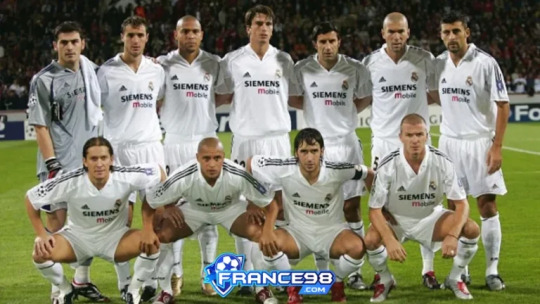
Real Madrid là một trong những câu lạc bộ bóng đá thành công nhất trong lịch sử, đã giành được nhiều danh hiệu và thành tích đáng chú ý trong cả nước và quốc tế. Dưới đây là một số thành tích nổi bật của CLB Real Madrid:
UEFA Champions League (Cúp C1 châu Âu):
13 lần đạt danh hiệu vô địch (1956, 1957, 1958, 1959, 1960, 1966, 1998, 2000, 2002, 2014, 2016, 2017, 2018).
La Liga (Giải vô địch bóng đá Tây Ban Nha):
34 lần đạt danh hiệu vô địch (1932, 1933, 1954, 1955, 1957, 1958, 1961, 1962, 1963, 1964, 1965, 1967, 1968, 1969, 1972, 1975, 1976, 1978, 1979, 1980, 1986, 1987, 1988, 1989, 1990, 1995, 1997, 2001, 2003, 2007, 2008, 2012, 2017, 2020).
Cúp Nhà vua Tây Ban Nha (Copa del Rey):
19 lần đạt danh hiệu vô địch (1905, 1906, 1907, 1908, 1917, 1934, 1936, 1946, 1947, 1962, 1970, 1974, 1975, 1980, 1982, 1989, 1993, 2011, 2014).
Siêu Cúp Tây Ban Nha (Supercopa de España):
11 lần đạt danh hiệu vô địch (1988, 1989, 1990, 1993, 1997, 2001, 2003, 2008, 2012, 2017, 2019).
Cúp Câu lạc bộ bóng đá Thế giới FIFA (FIFA Club World Cup):
4 lần đạt danh hiệu vô địch (1960, 1998, 2002, 2014).
Cúp UEFA (Europa League):
2 lần đạt danh hiệu vô địch (1985, 1986).
Cúp C2 châu Âu (Cúp Các nhà vô địch cúp quốc gia châu Âu):
2 lần đạt danh hiệu vô địch (1985, 1986).
Cúp bóng đá châu Âu/Liên đoàn các câu lạc bộ châu Âu (UEFA Cup Winners' Cup):
2 lần đạt danh hiệu vô địch (1962, 1983).
Real Madrid cũng nổi tiếng với việc có nhiều cầu thủ giành giải Quả bóng vàng FIFA (FIFA Ballon d'Or), bao gồm Cristiano Ronaldo, Alfredo Di Stéfano, Raymond Kopa, Luís Figo, Ronaldo, Zinedine Zidane và nhiều người khác.
Kết luận
Trên đây là những thông tin ngắn gọn về câu lạc bộ Real Madrid được chúng tôi chọn lọc gửi đến cho bạn đọc. Hy vọng rằng bài viết này sẽ có ích cho bạn khi đang muốn tìm hiểu về CLB chuyên nghiệp này.
Xem thêm: https://france98.com/cau-lac-bo-bong-da-real-madrid/
0 notes
Link
🏆 Billy McNeil, a Scottish football legend, was a prominent figure in the sport during the 1960s and 1970s. He captained Celtic FC, leading them to their first European Cup victory in 1967. 🌟 McNeil played for Celtic for 18 years, making over 800 appearances and winning numerous titles. He was known for his leadership skills, physicality, and aerial ability. 👑 After retiring from playing, McNeil went on to manage several clubs, including Celtic, Manchester City, and Aston Villa. He passed away in 2019, leaving behind a legacy as one of the greatest footballers and managers in Scottish history.1. Billy McNeil: A Brief Biography of the Football LegendBilly McNeil was a Scottish footballer and manager born in 1940. He played as a centre-back for Celtic and won 31 trophies in his career. He captained the Celtic team that won the European Cup in 1967. He also played for Scotland and managed Celtic, Manchester City, and Aston Villa. McNeil was known for his leadership skills and his ability to read the game. He was a tough defender and had a strong aerial game. He was also a great motivator and inspired his teammates to perform at their best. He was inducted into the Scottish Football Hall of Fame in 2004. McNeil passed away in 2019, but his legacy lives on. He is remembered as one of the greatest players and managers in Celtic's history. He was a true legend of Scottish football and will always be missed. 👑🏆🏅 Rest in peace, Billy McNeil. You will never be forgotten. 🙏2. The Early Football Career of Billy McNeil: From School to Professional Leagues🏈 Billy McNeil's football career began in school, where he played for the local team. He quickly gained a reputation as a talented player and caught the attention of professional scouts. 🏆 In 1957, McNeil signed with Celtic FC, one of the most successful teams in Scottish football history. He quickly became a regular player and helped the team win multiple championships. 🌎 McNeil also played for the Scottish national team, representing his country in international matches. He was known for his strong defensive skills and leadership on the field. 👨👩👧👦 McNeil's success on the field made him a beloved figure among fans, and he remained a prominent figure in Scottish football even after retiring as a player. 🎖️ Throughout his career, McNeil earned numerous awards and accolades, including induction into the Scottish Football Hall of Fame. He remains a legend in the world of football and an inspiration to young players everywhere.3. Billy McNeil's Achievements as a Player: A Glance at His Trophies and AwardsBilly McNeil was a legendary footballer who had an illustrious career. He won numerous trophies and awards during his playing days. Here are some of his most notable achievements: 🏆 McNeil won nine Scottish League titles with Celtic FC, including six in a row from 1966 to 1971. He was also a part of the team that won the European Cup in 1967, the first British team to do so. 🏅 In addition to his domestic and European success, McNeil also represented Scotland at the international level. He earned 29 caps for his country and was the captain of the team that qualified for the 1974 World Cup. 🥇 McNeil was recognized for his contributions to the sport with several individual awards. He was named Scottish Footballer of the Year in 1967 and was inducted into the Scottish Football Hall of Fame in 2004. 🏅 McNeil's achievements as a player are a testament to his skill, dedication, and passion for the game. He remains an inspiration to footballers everywhere and his legacy will continue to be celebrated for years to come.4. Billy McNeil's Contribution to Celtic FC: His Role as a Captain and ManagerBilly McNeil was a legendary figure at Celtic FC, serving the club both as a captain and manager. As a player, McNeil captained the club to their historic European Cup victory in 1967. He also won nine Scottish league titles and seven Scottish Cups during his playing career. McNeil returned to the club as manager in 1978, leading them to four league titles and a Scottish Cup. McNeil's leadership and passion for the club made him a beloved figure among fans. He was known for his motivational speeches and ability to inspire his players. McNeil also had a keen eye for talent, bringing in players like Paul McStay and Mo Johnston. His legacy at Celtic FC is still celebrated today, with a statue of him outside the stadium. McNeil's contribution to Celtic FC cannot be overstated. He embodied the club's values of hard work, determination, and loyalty. McNeil will always be remembered as one of the greatest captains and managers in the club's history. 🍀 5. Remembering Billy McNeil: Tributes and Condolences from the Football World Billy McNeil, Celtic's legendary captain and manager, passed away on April 22, 2019, at the age of 79. The football world mourned his loss, and tributes poured in from all corners of the globe. 🌎 🌍 🌏 Former Celtic player and manager, Neil Lennon, described McNeil as a "giant of the game" and a "true leader." Sir Alex Ferguson hailed him as a "great friend" and "one of the finest players" he had ever seen. 👏 👍 🙌 Scottish FA President, Alan McRae, paid tribute to McNeil's "outstanding contribution" to Scottish football. Liverpool FC tweeted, "We are deeply saddened by the passing of Billy McNeil, a true giant of the game." 💔 😢 🌟 Former Celtic player, Chris Sutton, tweeted, "Billy McNeil was a giant of a man and a true leader. He was a great captain, manager, and ambassador for Celtic Football Club. RIP Cesar." 💚 💪 👑 McNeil's legacy will live on, and he will always be remembered as a true legend of the game. 🏆 👏 🙏 6. The Legacy of Billy McNeil: How His Impact on Football Continues to Inspire Future GenerationsBilly McNeil's impact on football was immense. His leadership, determination, and passion for the game continue to inspire future generations. He captained Celtic to their first European Cup victory in 1967, becoming the first British team to win the competition. He also won nine Scottish league titles and seven Scottish Cups during his time at Celtic. McNeil's success as a player translated to his coaching career, where he led Celtic to three league titles and a Scottish Cup. Off the pitch, McNeil was known for his humility and kindness. He was a true ambassador for the sport and a role model for young players. He was inducted into the Scottish Football Hall of Fame in 2004 and received a CBE for his services to football in 2019. McNeil's legacy lives on through the Billy McNeil Foundation, which supports children with cancer and their families. His impact on football and the wider community will never be forgotten. McNeil's determination and leadership have inspired countless players and coaches, including current Celtic manager Neil Lennon. Lennon said, "Billy was a giant of the game and a true Celtic legend. His legacy will live on forever." McNeil's influence can also be seen in the way Celtic play, with a focus on attacking football and a never-say-die attitude. His impact on the sport will continue to inspire future generations of players and coaches. 👏 Billy McNeil's impact on football is a testament to his skill, leadership, and passion for the game. His legacy will continue to inspire future generations of players and coaches. 👏 In conclusion, Billy McNeil will always be remembered as a football legend. He was a true leader on and off the pitch, inspiring generations of players to come. His passion for the sport and dedication to his team made him a beloved figure in the football community. 🏆⚽️ McNeil's legacy lives on through the countless memories he created during his career. His achievements and contributions to the sport will forever be etched in history. He will always be an inspiration to young footballers around the world. 🌍👦⚽️ We salute Billy McNeil for his remarkable career and for being a role model to many. His impact on the sport will never be forgotten. Rest in peace, Billy McNeil. 🙏⚽️ https://emergencyvet.uk/billy-mcneil-veteran-football-legend/?_unique_id=6476c29df3ce7
0 notes
Text
Just Fontaine, World Cup finals record goal-scorer dies at 89
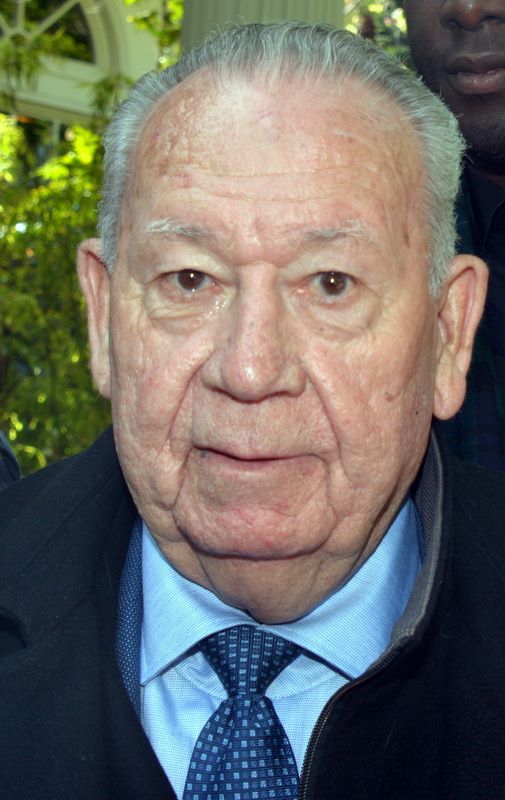
Just Fontaine, the all-time top scorer in a single World Cup finals with 13 goals, has died at the age of 89, his family told AFP on Wednesday.
Fontaine achieved the record in the 1958 finals in Sweden where France reached the semi-finals for the first time in their history, losing to Pele’s Brazil.
Part of a wonderful attacking trident at that World Cup alongside Roger Piantoni and Raymond Kopa, Fontaine might never have gone to Sweden at all.
Only injuries to fellow forwards Thadee Cisowski and his Reims teammate Rene Bliard saw him make the squad and then the starting line-up.
Fontaine also won four French league titles, one with Nice and three with the great Reims side of the post-war era.
He played in the Reims team that lost to the Real Madrid of Alfredo di Stefano, Ferenc Puskas and Raymond Kopa in the 1959 European Cup final.
Fontaine was then forced to retire in 1962 at the age of just 28 after he suffered a double leg fracture.
He later moved into management, lasting just two matches in charge of France in 1967 before leading Paris Saint-Germain to promotion to the top division in 1974 and then coaching Morocco to third place at the 1980 Africa Cup of Nations.
Read the full article
0 notes
Text
In 1999, who became the main presenter of the British TV show 'Match of the Day'?
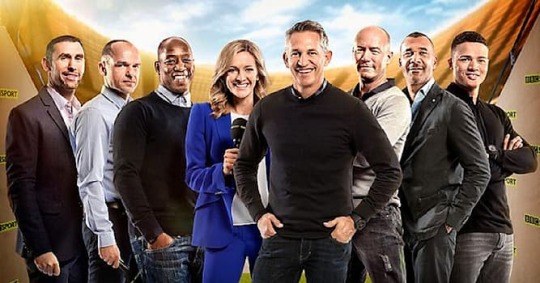
'Match of the Day' is a British television show featuring highlights, interviews and analysis from expert pundits of Saturday's English Premier League football (soccer) matches. It is one of the BBC's longest-running shows, having been on air since 22nd August 1964, and is recognised as the longest-running football television programme in the world. Since 1999, Gary Lineker has been the presenter of the show. He was preceded by Des Lynam (1988-1999), Jimmy Hill (1973-1988), David Coleman (1967-1973) and Kenneth Wolstenholme (1964-1967).
Lineker (born 1960) is a retired footballer who played for the English national team. He began his football career at Leicester City in 1978, and joined England in 1984, scoring 48 goals over an eight-year international career. Notably, he never received a yellow or red card throughout his football career, earning him the Fair Play Award in 1990. As well as England and Leicester City, Lineker played for Everton, Barcelona, Tottenham Hotspur and Nagoya Grampus. He retired in 1994.
Since 1998, 'Match of the Day' also covers the FIFA World Cup and the UEFA European Championship. The title of the show is sometimes shortened to 'MOTD' and there have been several spin-off shows in order to cover as many football matches as possible. These include 'Match of the Day 2', 'Match of the Day 2 Extra', 'Match of the Day Kickabout', 'Football Focus', 'Final Score', and 'The Premier League Show'.
0 notes